By: Byron Mathioudakis
With Fringe Benefit Tax exemptions and lower running costs, electric vans will become a more viable way to reduce business costs in addition to transport emissions as the range on offer in Australia increases.
RELATED:
- Best Electric Cars coming to Australia in 2025 »
- Electric Cars available in Australia »
- Electric SUVs available in Australia »
- Small Electric Cars available in Australia »
- Electric and Hybrid Utes available in Australia »
LDV eDeliver 7 van from under $59,990
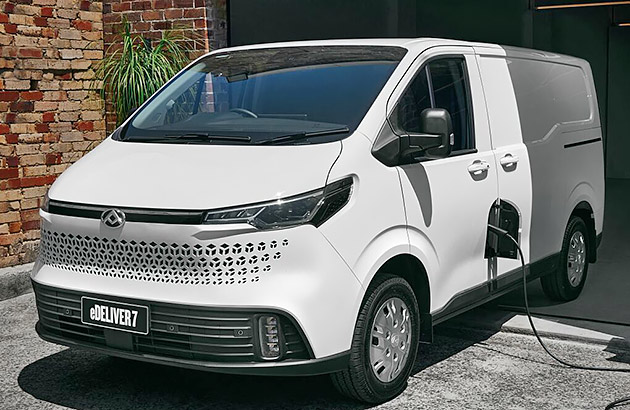
Chinese brand LDV continues to set the EV pace in Australia with a midsized van costing barely more than premium diesel alternatives from Europe, Korea and Japan.
Available with a short or long wheelbase – the latter in low or high roof sizes – the eDeliver 7 uses a 150kW electric motor powered by either a 77kWh battery with up to 318km (WLPT) of range, or an 88kWh battery offering 362km (WLPT).
Standard features include extensive driver-assist safety tech, a reverse camera, front and rear parking sensors, heated seats, proximity locking/unlocking and a big 12.3-inch screen.
Payload is between 1175kg and 1350kg, while load volumes vary from 5.9 cubic metres to 8.7m3.
Replenishing the smaller battery to 80 per cent using a 50kW DC outlet takes about 90 minutes. Using an optional 7kW Wallbox, around 13 hours is required to 100 per cent, or nearly 44 hours plugged into a normal home socket.
Modern, practical and affordable, the eDeliver 7 EV makes sense.
| Motor: | Synchronous electric permanent-magnet |
|---|---|
| Transmission/drive: | Single-speed reduction gear/FWD |
| Battery: | 77kWh or 88kWh Lithium Ion |
| Power/torque: | 150kW/310Nm |
| 0-100km/h: | N/A |
| Consumption: | N/A |
| Electric range: | 310km to 362km |
| Warranty: | 5yr/160,000km |
| Battery warranty: | 8yr/160,000km |
| Safety rating: | Gold |
Peugeot e-Partner from $59,990
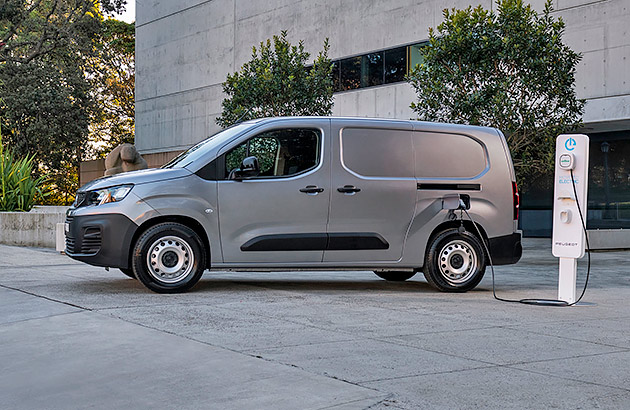
Renault was first with an electric van in Australia with the Kangoo ZE EV several years back, but archrival Peugeot’s e-Partner has stepped up with a compelling alternative.
Built in France and launched in late 2023 in long-wheelbase Pro Long guise, the e-Partner offers a clever and car-like two-seater front cabin, featuring an array of comfort and safety equipment.
Meanwhile, out back, payload is 800kg, braked towing capacity is just 750kg and load volume is 3.9 cubic metres.
Car-like to drive, the e-Partner sits on the acclaimed 308 hatchback’s modular platform, with a 100kW electric motor driving the front wheels. A 50kWh battery provides a modest 245km of range.
As with the related Peugeot e-2008 EV SUV, replenishing the battery from 10-80 per cent with a 50kW DC public charger requires around 45 minutes, or nearly eight hours to 100 per cent with an optional 7kW Wallbox and 24 hours via a household socket.
| Motor: | Synchronous electric permanent-magnet |
|---|---|
| Transmission/drive: | Single-speed reduction gear/FWD |
| Battery: | 50kWh Lithium Ion |
| Power/torque: | 100kW/260Nm |
| 0-100km/h: | 11.7s |
| Consumption: | 19.6 kWh/100km (estimated) |
| Electric range: | 245km |
| Warranty: | 5yr/200,000km |
| Battery warranty: | 8yr/160,000km |
| Safety rating: | 5 stars |
Renault Kangoo E-Tech from $61,990 (estimated)
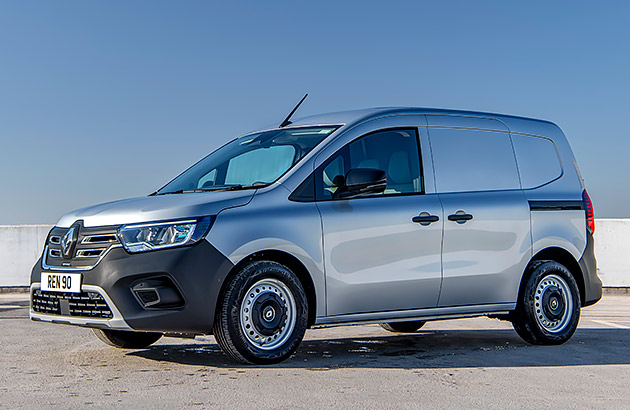
The Renault Kangoo E-Tech is the brand’s second-gen EV van.
Launched in late 2023, it kicks off with the L1 Compact Pro, measuring in at nearly 4.5 metres long. It includes a 608kg payload, a leading 1500kg braked towing capacity (750kg unbraked) and 3.3 cubic metre load volume.
There’s also the L2 Maxi, with a stretched body and wheelbase. Payload increases to nearly 764kg while load volume is 4.2 cubic metres.
A 90kW/245Nm motor powered by an underfloor 45kWh battery drives the front wheels, resulting in a modest 285km range.
Plugging into a 50kW DC public charger will get the Renault from 10 to 80 per cent full in around 60 minutes, or nearly seven hours to 100 per cent with an optional 7kW Wallbox and 23 hours via a household socket.
Civilised, comfortable, spacious and functional inside, the Kangoo E-Tech reflects its maker’s long experience making compact vans.
| Motor: | Synchronous electric permanent-magnet |
|---|---|
| Transmission/drive: | Single-speed reduction gear/FWD |
| Battery: | 45kWh Lithium Ion |
| Power/torque: | 90kW/245Nm |
| 0-100km/h: | 11.6s |
| Consumption: | 19.2 kWh/100km (estimated) |
| Electric range: | 285km |
| Warranty: | 5yr/100,000km |
| Battery warranty: | 8yr/160,000km |
| Safety rating: | N/A |
Peugeot E-Expert from $79,990
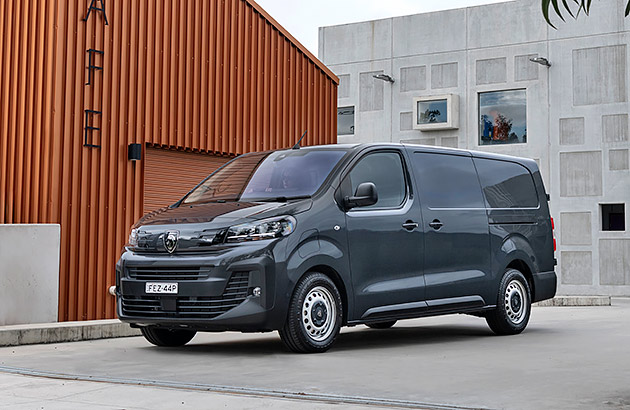
Priced above similarly-sized Chinese competition but below some European EV midsizers, the E-Expert is a stylish three-seater van from France.
Positioned above the smaller E-Partner, the electric Peugeot workhorse is only offered in long-wheelbase Pro Long guise for now, with a one-tonne payload and 6.1 cubic metres of loading volume.
In Europe, the E-Expert dates back to 2019, but was recently heavily revised, with a big facelift, completely redesigned interior offering two 10-inch display screens, updated driver-assist safety and other improvements. Adaptive cruise control, wireless charging, parking sensors all round and a 180-degree camera are included.
Recharging the battery from 10-80 per cent with a 50kW DC public needs about 90 minutes, or around 24 hours to 100 per cent with an optional 7kW Wallbox and up to 36 hours plugged into the mains at home.
Good looks, zippy performance, enjoyable handling and thoughtful, practical packaging are amongst the E-Expert’s various highlights.
| Motor: | Synchronous electric permanent-magnet |
|---|---|
| Transmission/drive: | Single-speed reduction gear/FWD |
| Battery: | 75kWh Lithium Ion |
| Power/torque: | 100kW/260Nm |
| 0-100km/h: | 13.1s |
| Consumption: | 24.4 kWh/100km (estimated) |
| Electric range: | 330km |
| Warranty: | 5yr/200,000km |
| Battery warranty: | 8yr/160,000km |
| Safety rating: | Silver |
Ford E-Transit van from $89,990
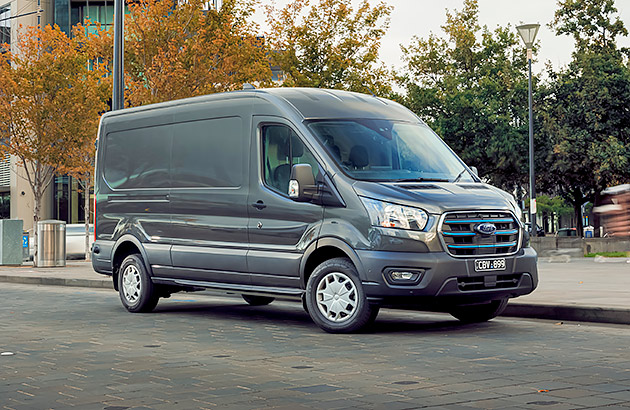
The E-Transit is based on the big-body Transit Heavy and is initially only offered in the rear-wheel drive 420L long-wheelbase body style.
The most powerful Transit ever, it comes with a 68kWh battery pack slung underneath, so as not to impact carrying capacity.
To that end, there’s up to 11cubic metres of space in the mid-roof size and 12.4 cubic metres in $1500-extra high-roof versions, matching the regular Transit diesel equivalents. Gross vehicle mass of up to 4250kg is claimed, with a maximum payload of 1616kg.
New suspension is said to deliver improved steering, handling, control and ride comfort properties.
Find a 50kW-plus public charging station and the battery can be replenished from 10 to 80 per cent in about an hour, or to 100 per cent in under 12 hours with an optional 7kW Wallbox. Plugging in at home could take over 33 hours.
Now much cheaper than when launched in 2023, and with a 40 per cent reduction in service costs, the E-Transit now makes a strong case for itself.
| Motor: | Synchronous electric permanent-magnet |
|---|---|
| Transmission/drive: | Single-speed reduction gear/RWD |
| Battery: | 68kWh Lithium Ion |
| Power/torque: | 198kW/430Nm |
| 0-100km/h: | N/A |
| Consumption: | 30-35kWh/100km (estimated) |
| Electric range: | 295/307km |
| Warranty: | 5yr/unlimited |
| Battery warranty: | 8yr/160,000km |
| Safety rating: | Gold |
Mercedes-Benz eVito and EQV vans from $98,958
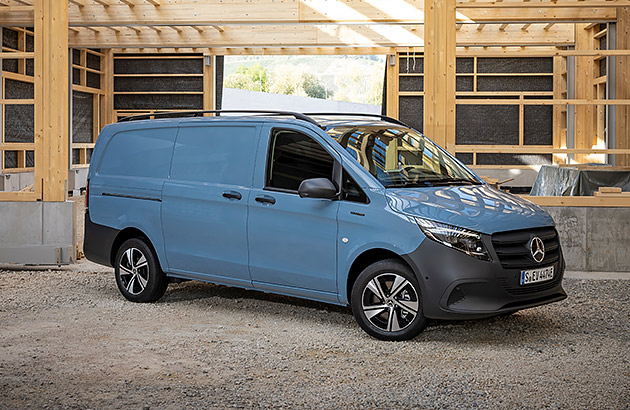
Derived from the diesel V-Class series that have been around for a decade, the eVito Van and Tourer (from around $140,000) are commercial van and people-mover models respectively, while the EQV (from about $165,000) is a more-lavishly equipped luxury people-mover proposition.
All underwent a facelift in mid-2024, bringing improved safety, technology and features.
The eVito Tourer and EQV use a 150kW motor and 90kWh battery to power the front wheels.
Using a 50kW public DC fast charger, the 90kWh battery requires about 80 minutes to go from 10 to 80 per cent charge. A 100 per cent top-up with a 7kW Wallbox needs nearly 15 hours, or almost 48 hours with a regular home socket.
Meanwhile, the eVito Van employs an 85kW electric motor and 60kWh battery pack, for a WLTP range of 242km. The thinking here prioritises more-affordable pricing and quicker recharging. Charging times are about two-thirds those of the 90kWh battery.
The batteries are laid under the cabin floor to minimise interior-space interference.
The people movers provide standard eight-person or more-luxurious six-person seating configurations.
| Motor: | Synchronous electric permanent-magnet |
|---|---|
| Transmission/drive: | Single-speed reduction gear/FWD |
| Battery: | 60kWh (van), 90kWh (people movers) Lithium Ion |
| Power/torque: | 85kW/360Nm (van), 150kW/366Nm (people movers) |
| 0-100km/h: | 12.1s |
| Consumption: | 21.3 to 27.6kWh/100km |
| Electric range: | 242-314km (van) 356-361km (people movers) |
| Warranty: | 5yr/unlimited |
| Battery warranty: | 8yr/160,000km |
| Safety rating: | Platinum |
LDV eDeliver 9 van from under $99,990
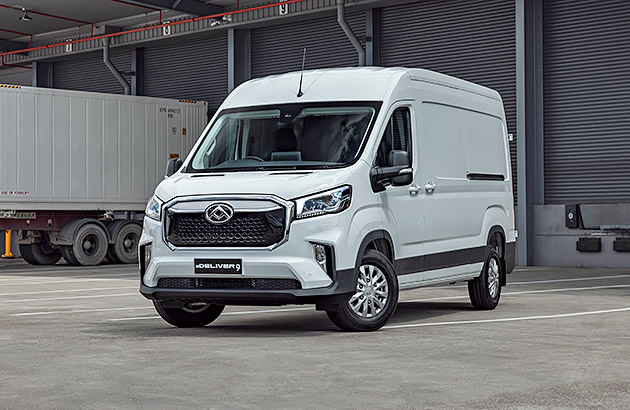
The popular Deliver 9 from LDV of China gains the all-important ‘e’ prefix.
Available in three variants – a long-wheelbase mid-roof van, a long-wheelbase high-roof van and a cab-chassis – the vans use an 88kWh battery to power a front-mounted 150kW motor, for up to 280km of range. Top speed is limited to just 90km/h.
Note there is also a cab-chassis ute from $99,990, with a smaller, 65kWh battery, offering 150km of range.
Charging the 88kWh battery from a 10-80 per cent using a 50kW DC public outlet requires around 100 minutes, or for 100 per cent about 15 hours with an optional 7kW Wallbox. A regular home socket could take up to 50 hours.
Interior or cargo space has not been impacted in this van’s transition from diesel to electric, with 10.97 and 12.33 cubic metres of space offered in the mid and high-roof vans respectively. Payload is 1410kg for the mid-roof and 1350kg for the high-roof, while braked towing capacity is rated at 1500kg for all.
| Motor: | Synchronous electric permanent-magnet |
|---|---|
| Transmission/drive: | Single-speed reduction gear/FWD |
| Battery: | 65kWh or 88.5kWh Lithium Ion |
| Power/torque: | 150kW/310Nm |
| 0-100km/h: | N/A |
| Consumption: | 33.9kWh/100km |
| Electric range: | 280km (88.5kWh), 150km (65kWh) |
| Warranty: | 5yr/160,000km |
| Battery warranty: | 8yr/160,000km |
| Safety rating: | Gold |
Mercedes-Benz eSprinter panel van from $104,313
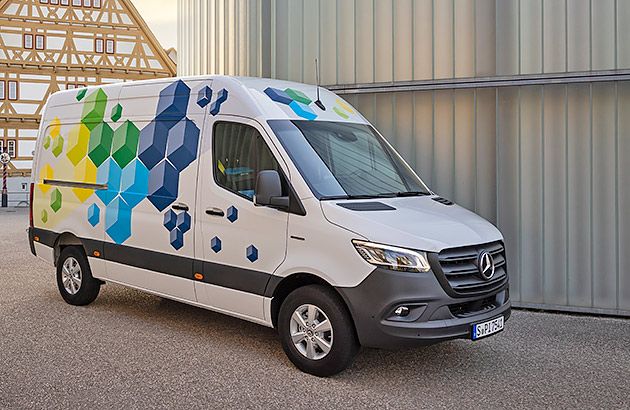
In Mercedes-speak, Sprinter means full-sized van, and if you’re searching for massive capacity, the German does not disappoint.
The latest generation dates back to late last decade, but the eSprinter EV version only launched in Australia in mid-2024. It arrived as part of an extensive mid-life facelift for the regular diesel models, that included more safety, updated multimedia and improved comfort.
The EV comes in two, two-seater panel van configurations for now – a mid-wheelbase, six-metre-long model employing an 81kWh battery and long-wheelbase seven-metre long version with a sizeable 113kWh battery.
The former offers a 1523kg payload and the latter 1115kg. Both have a 2000kg towing capacity.
Using a 50kW public DC fast charger, the 81kWh battery requires about 70 minutes to 80 per cent charge. A 100 per cent top-up with a 7kW Wallbox needs nearly 13hours, or almost 45 hours with a regular home socket. Add an extra 40 per cent to those times for the 113kWh battery version.
| Motor: | Synchronous electric permanent-magnet |
|---|---|
| Transmission/drive: | Single-speed reduction gear/RWD |
| Battery: | 81kWh or 113kWh Lithium Ion |
| Power/torque: | 150kW/4000Nm |
| 0-100km/h: | N/A |
| Consumption: | 28 to 34.6kWh/100km |
| Electric range: | 359km (81kWh), 440km (113kWh) |
| Warranty: | 5yr/250,000km |
| Battery warranty: | 8yr/160,000km |
| Safety rating: | Platinum |
Electric range is quoted using the World harmonised Light vehicle Testing Procedure (WLTP), or otherwise are manufacturers’ claims.
Members save 10% on RAC's Home EV chargers
Faster, smarter, convenient - power your EV at home with our 7.4kW and 22kW chargers. Includes full installation and an app for easy scheduling.
